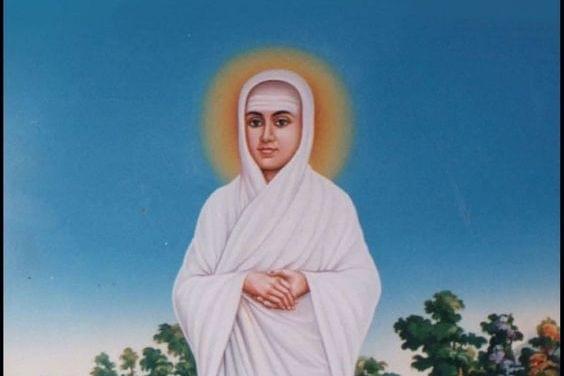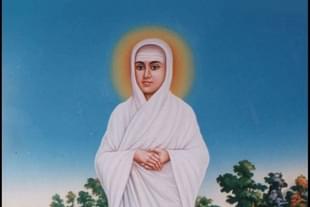Politics
Tamil Nadu: Why Vallalar's Sanmargam Was Sanatana Dharma Itself
Aravindan Neelakandan
Jun 24, 2023, 01:28 PM | Updated 01:28 PM IST
Save & read from anywhere!
Bookmark stories for easy access on any device or the Swarajya app.


The Tamil Nadu Governor is right about Vallalar.
His Sanmarga was indeed rooted in the timeless principles of Sanatana Dharma.
In Tamil Nadu, many historical distortions effected by Dravidianism have been prevalent for many years now.
One such distortion is regarding Saint Ramalinga Swamigal (1823-1874), who was popularly known as 'Vallalar'.
This great saint of Tamil Nadu is depicted as a rebel against Sanatana Dharma. According to Dravidianist narrative, he was a forerunner of E.V.Ramaswamy Naicker's ideology.
So, when the Governor of Tamil Nadu, R.N. Ravi, attended the 200th birth anniversary celebrations of the saint at Vadalur—where Vallalar founded his mission—and spoke highly of Vallalar's role in Sanatana Dharma, it naturally provoked the Dravidianists.
Vallalar - Anti-Sanatani?
The ruling Dravida Munnetra Kazhagam (DMK) leader and Finance Minister of Tamil Nadu, Thangam Thenarasu, took to social media to condemn the Governor.
He said that the 'Suddha Sanmarga Neri' of Vallalar was fundamentally different from Sanatana Dharma. He further stated that the Governor was distorting Vallalar's ideas and was force-fitting the saint into Sanatana Dharma.
Marxist politician and Member of Parliament from Madurai, Su Venkitesan, also criticized the Governor, saying that Vallalar was against religious practices. Both Vallalar and Thiruvalluvar were rebels and primordial Tamil voices that drove away Sanatana Dharma, according to the Madurai MP.
The Different Sanatana Dharmas
But what is Sanatana Dharma?
Swami Dayananda Saraswati was one of the earliest proponents of the term "Sanatana Dharma" in modern times. He founded the Arya Samaj, which opposed caste discrimination and untouchability.
The Arya Samajists, who identified with Vedic Sanatana Dharma, played a significant role in enacting laws that promoted women's education and banned child marriages. At the same time, there were also orthodox individuals who called themselves Sanatanists and opposed the Arya Samaj.
Even while fighting against untouchability, Mahatma Gandhi had openly declared himself a Sanatani Hindu.
Mahayogi Sri Aurobindo, in his famous Uttarpara speech, shared a profound perspective on Sanatana Dharma:
Sanatan Dharma is life itself; it is a thing that has not so much to be believed as lived. ... That which we call the Hindu religion is really the eternal religion, because it is the universal religion which embraces all others. If a religion is not universal, it cannot be eternal. A narrow religion, a sectarian religion, an exclusive religion can live only for a limited time and a limited purpose.
When the TN Governor uses the term 'Sanatana Dharma', he clearly associated it with the interpretation put forth by Sri Aurobindo and Mahatma Gandhi.
Tying the term to the negativity of birth-based discriminations is nothing but a colonial fallacy. It shows the time-warp in which the Dravidianist minister and Marxist MP have shut themselves in.
Vallalar and Sanatana Dharma: A Historical Context
The Governor made a poignant statement about Vallalar's role in upholding a crucial aspect of Sanatana Dharma during a challenging time when colonial rule, particularly in southern India, was being established.
The British East India Company (EIC) was gaining a foothold in the Madras Presidency and was involved in frequent wars and conflicts. It required a strong army that in turn relied on a significant amount of beef for sustenance.
To this end, the British faced a dilemma due to the cultural taboo against beef consumption in India. To overcome this, they exploited social divisions and promoted beef consumption and butchery centres.
This led to debates and concerns about cow protection. The colonial education system further propagated the notion that cow protection was a superstition.
Vallalar keenly observed these societal changes and also noticed how the British were altering the agro-economic system. The latter resulted in increased social disparities, and in empowering certain communities while marginalizing others and pitting them against each other.
Vallalar foresaw the potential disasters, such as famine, that could arise from such changes in the near future.
During that period, in 1854, Vallalar was approached to write a prose text aimed at imparting cultural literacy and values to future generations.
He chose to base his work on the traditional history of Manu Neethi Kanda Cholan, the Chola king who sacrificed his own son to seek justice for a grieving cow.
In the dialogues he crafted, Vallalar presented arguments from courtiers and Pandits that bore a striking resemblance to the pro-cow slaughter arguments made by colonial and allied forces of the era.
'Is not cow just another animal inferior to man?'
'Are there not Shastric remedies for killing of the cow and her progeny?'
'So why bother about the animal?'
Vallalar responded to these arguments in great detail through the story of the Chola king. It was a response that holds valuable insights that are worthy of being presented in full:
Of all births being born as a cow is considered superior. Under its horns are Brahma and Vishnu. At the tip of its horns are the sacred water bodies like Kaveri. In its head resides Siva and in its forehead Shakti. Subrahmanya is in her nostrils. In her ears are the Asvini Devas. Her eyes are the sun and the moon and Varun resides in her tongue, Sarasvati in the sounds she makes and the Gandharvas reside in her chest. Indra resides in her neck and Rudras reside in her back. The Sapta-Matrika reside in her genitals. Lakshmi resides in her anus. Ganga abides in her urine. Earth goddess resides in her stomach. Yamuna is in her dung. The ocean of milk is in her udders and the fire of all sacrifices is in her vital organs of stomach, heart and face. Great of the women like Arundhadti reside all over her body. So it is said. Further she gives us treasured milk with which we bath Siva and she is the basis for the production of holy ash. She is the mother of that bull of Siva which has the four Vedas as its legs, Karma and wisdom as its eyes, Scriptures as its horns, Dharma itself as its body and penance as its gait. Can we consider such a cow as just animal?
Thus we see that Vallalar strongly advocated for cow protection, and was completely in line with the Hindu belief in the sacredness of the cow.
It's also worth noting that alongside cow protection, Vallalar also played a significant role in reviving and institutionalising the continuous offering of food known as 'Dana'.
Several years after Vallalar's merging with the divine light ('Jothi'), southern India experienced a devastating famine called the Deccan famine of 1876-78. Sadly, this famine, often omitted from textbooks, resulted in the loss of 6-10 million Indian lives.
Considering this historical context, one can appreciate the timely and relevant efforts made by Vallalar to revitalise and institutionalise the concept of Anna Dana (food donation). His devotion to cows should also be understood within this broader context.
In both Sanskrit and Tamil traditions, offering Anna Dana (food donation) is considered the greatest act of merit and a sacred vow. The Taittiriya Upanishad explains that water gave rise to land, land gave rise to plants, plants gave rise to food, and food sustains human life.
In the Purananooru, a poet advises a king that ensuring food production and distribution leads to eternal fame, as giving food is akin to giving life, and food originates from the combination of land and water.
The Taittiriya Upanishad further emphasizes that abundant food production is an inviolable vow, and endlessly providing food to those in need is one too.
Vallalar's teachings and actions revived this essential aspect of Sanatana Dharma, particularly in anticipation of colonial famine disasters.
The Tamil Nadu Governor recognized the presence of divine incarnation in every age, as promised in the Bhagavad Gita, within Vallalar's spiritual path.
This acknowledgement reveals the historical truth of Vallalar's connection to Sanatana Dharma, contradicting the mistaken beliefs promoted by Dravidianist ideologies.
Veer Savarkar and Vallalar Swamigal
It is worth noting that Vallalar himself saw his role as one representing the continuous emergence of Dharmic seers. He believed that the Hindu Veda-Agamas scriptures alone contained the knowledge of attaining immortality, considering other scriptures as approximations of what the Veda-Agamas contained.
Deathlessness is Sanatana. While Vallalar emphasized the transcendence of religious boundaries through the divine experience of 'Sutha Siva Anubhava', he also highlighted the spiritually evolved nature of the Hindu Veda-Agamas in the context of various religions.
This perspective resonates with Veer Savarkar's words, who, too, emphasized that a Hindu, at the peak of their Hindu identity, transcends sectarianism and embraces the entire universe as their home.
Another intriguing coincidence between Vallalar and Savarkar is the symbolism they incorporated in their respective flags.
Vallalar designed his Sanmarga flag to represent the movement from "nabi" (navel) to the middle of the brows, symbolizing the path to blissful realization.
Similarly, Savarkar incorporated Kundalini movement in the flag of the Hindu Mahasabha.
Despite minor differences, both Vallalar and Savarkar inscribed the symbolism of the spiritual path and the realization of sadhana (spiritual practice). They considered it a gift and fundamental right for every human being, regardless of caste, creed, gender, or race, to attain this realization.
Therefore, Vallalar's Sanmarga is deeply rooted in the timeless principles of Sanatana Dharma. It truly embodies the essence of Sanatana Sanmarga.
Aravindan is a contributing editor at Swarajya.





